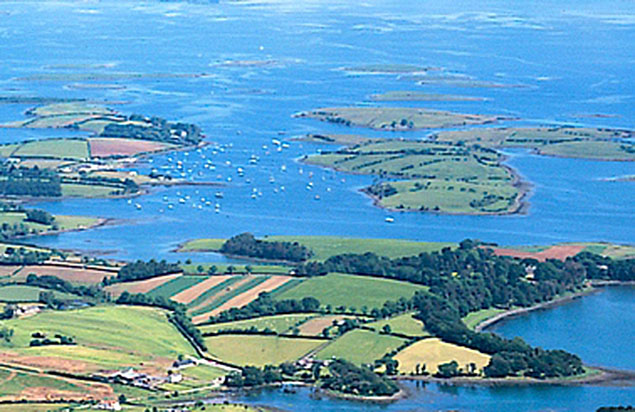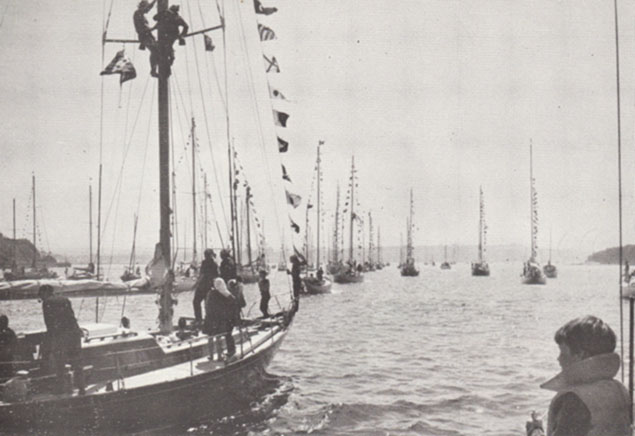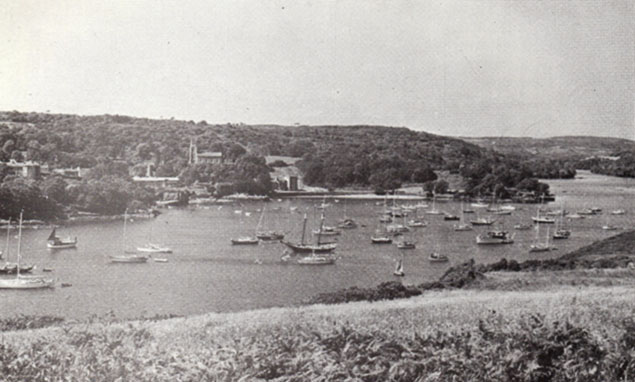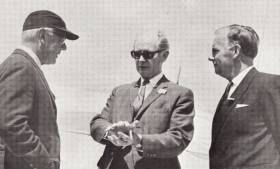Displaying items by tag: Dennis Faulkner
Sir Dennis Faulkner 1926-2016
One of the most noted sailing figures in Northern Ireland, Sir Dennis Faulkner died peacefully at his home close along the shore beside the hidden waters of Ringhaddy Sound in Strangford Lough at the age of 90 on New Year’s Eve.
Although in the public eye he may have been best known as the younger brother of Brian Faulkner, who was five years his senior and was Prime Minister of Northern Ireland in the early 1970s, while Dennis cherished his privacy he was active in voluntary naval and military service. This was in addition to being a leading businessman associated with several major companies, and he was also a very keen sailing enthusiast from childhood.
His boyhood was spent on the shores of Ballyholme Bay on Belfast Lough, and at an early age he showed his capacity to combine the skills of a seaman with the acumen of a considerable business talent. Spotting a dinghy drifting out of the bay in a strong offshore wind with the crew unable to cope with the conditions, he quickly effected a rescue. Yet by the time he was being praised by the local newspaper as “the schoolboy hero”, he personally was busy with pursuing an insurance claim for the salvage of the boat.
This combination of sailing ability with a businesslike approach to life was inherited from his father Jimmy Faulkner, who built up a commercial empire in Northern Ireland based initially on shirt manufacture, successfully maintaining contacts throughout Ireland and abroad both for business and sport. Thus when the first list of Irish Cruising Club members was compiled in 1930 after the club’s foundation in the summer of 1929, Jimmy Faulkner was on that inaugural list as owner of the 12-ton cutter Bryden.
 Dennis Faulkner’s spiritual home, where he built his dream house and off it moored a succession of fine yachts
Dennis Faulkner’s spiritual home, where he built his dream house and off it moored a succession of fine yachts
Later, in the summer of 1930, he went to his favourite cruising area, the West Coast of Scotland, in company with the new ICC’s first Commodore, Herbert Wright of Dun Laoghaire with his 15-ton cutter Espanola. Soon afterwards, Jimmy Faulkner presented the Irish Cruising Club with its first trophy, the Faulkner Cup. This led to the annual log competition which was instituted in 1931, and today it is the senior Irish cruising award, still competed for annually by boats and crews who have been to every corner of the world.
Initially, while young Dennis crewed from time to time with his father, racing was his primary interest, and he was seldom without a boat in one of the north’s leading One-Design classes. Much of his sailing focus had moved to Strangford Lough where he was involved with the River and Glen classes at Whiterock, but as he continued to live near the shores of Belfast Lough he also played an active role in the introduction of the Squib Class at Royal North of Ireland YC at Cultra.
However, when time permitted he participated in major international RORC events through a friendship with Geoffrey Pattinson who was best known for ownership of the successful Robert Clark-designed 55ft alloy sloop Jocasta , built 1950. With boats like this, Dennis Faulkner not only logged many ruggedly-raced offshore miles including several Fastnets, but he also built up a network of useful acquaintances who appreciated his toughness in hard-driving ocean conditions. As a result, he must have been one of the few people in all Ireland who had taken part in what used to be a southern hemisphere classic, the Buenos Aires-Rio de Janeiro Race.
In home waters, he also registered a win in a southwest gale as sailing master aboard a friend’s boat in the RUYC’s annual Ailsa Craig Race, but although he owned a succession of fine cruiser-racers, he was too fond of them to drive them to the uttermost in heavy weather. And having succeeded his father into membership of the Irish Cruising Club in 1960, the Hebrides continued to be the Faulkner family’s favourite cruising ground, where in time his liking for the Outer Hebrides was such that he bought a remote cottage on the shores of Loch Mariveg on the east coast of Lewis south of Stornoway. Any cruising enthusiasts who happened to find their way to this extremely secret spot found a very relaxed and hospitable Dennis Faulkner who had for the time being shed the cares of life back in Northern Ireland.
Inevitably his administrative talents were such that he joined the Irish Cruising Club Committee, and in 1969 he became Commodore ICC. At this stage his pet boat was the 49ft Robert Clark-designed Zest of Strangford, a hull-sister of Denis Doyle’s first Moonduster. The new Commodore ICC sailed Zest to Crosshaven to join the 1969 Cruise-in-Company of the leading cruising clubs – including a large Transatlantic contingent from the Cruising Club of America – as the opening salvo of the two year celebration of the Quarter Millennium of the Royal Cork Yacht Club.
 The Cruise-in-Company fleet in the Parade of Vessels in Cork Harbour which started the Royal Cork Yacht Club’s Quadrimillennial celebrations in 1969. Photo courtesy ICC
The Cruise-in-Company fleet in the Parade of Vessels in Cork Harbour which started the Royal Cork Yacht Club’s Quadrimillennial celebrations in 1969. Photo courtesy ICC
While voyaging to Cork, Zest had taken in tow a motor-boat with a broken-down engine. Whether or not this strained her own engine installation can only be guessed at, but during the Quadrimillennial Parade of Vessels under power round Cork Harbour – reviewed by An Taoiseach Jack Lynch – it was arranged that Zest would tow the engine-less Moonduster, and a problem occurred.
All was going well, the sun shone, the colours fluttered in the breeze, but then Zest’s propeller shaft fractured under the added load. However, Richard Nye’s famous 48ft Carina – then brand new and fresh in from racing Transatlantic – was next in line, and she took the two immobilised Irish boats in tow in such a smooth exercise that, as the two Dennises subsequently remarked, anyone watching assumed it was a pre-arranged and carefully-rehearsed part of the Parade.
That astonishing large-scale Cruise-in-Company – the first such in Irish waters - culminated in Glengarriff with a massive party at exactly the time the first American astronauts walked on the moon. It now all seems a very distant time ago, and in the long interval since, Dennis Faulkner never lost his love of sailing, while his fondness for Strangford Lough was eventually fulfilled by being able to build his dream home, a gently-styled house which blends well with its peaceful surroundings, on the shore of his beloved Ringhaddy Sound.
There, the Faulkner family showed what could be done in harmony with the environment, and his daughter and son-in-law have emerged among County Down’s leading horticulturalists. Dennis meanwhile continued his discerning pattern of cruising yacht ownership, his final serious voyaging craft being an Amel Super Maramu 54 ketch, a long way indeed from his father’s old clinker-built Scottish-style double-ender Bryden.
 The 1969 Cruise-in-Company in Castlehaven – the schooner is Integrity (CCA). The cruise concluded in Glengarriff at the end of July when the American astronauts first walked on the moon. Photo courtesy ICC
The 1969 Cruise-in-Company in Castlehaven – the schooner is Integrity (CCA). The cruise concluded in Glengarriff at the end of July when the American astronauts first walked on the moon. Photo courtesy ICC
The family involvement with the cruising community worldwide - and particularly in Ireland - continued, and it was way back in 1970 that Dennis Faulkner found himself faced with the task of adjudicating the ICC logs, a process which had been started by his father’s presentation of the Faulkner Cup in 1931.
In honour of this, and in acknowledgement of the growth of the club and its activities since, he inaugurated a new trophy, the Strangford Cup for “an alternative best cruise”, which he duly awarded for 1970 to Rory O’Hanlon of Dun Laoghaire for his cruise to the Lofoten Islands in northern Norway with his S&S sloop Clarion.
Dennis Faulkner’s greatest enjoyment lay in interacting with the sea, in its most open form when he was in his prime, and in the intimate waters of Strangford Lough as the years moved on. He never lost his adventurous spirit, and on sailing through Ringhaddy Sound one day, we were much impressed by seeing the man himself out for a quick spin on a windsurfer. His final boat was Whimbrel, a Hawk day-sailer, and with her he rounded out a very complete life afloat. Our thoughts are with his family and many friends in their sad loss.
WMN





























































